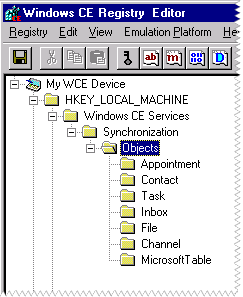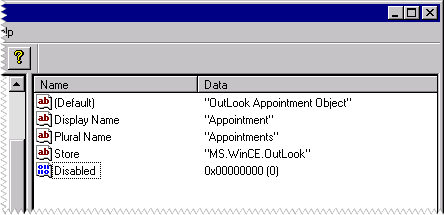 Important: Important: |
|---|
| This is retired content. This content is outdated and is no longer being maintained. It is provided as a courtesy for individuals who are still using these technologies. This content may contain URLs that were valid when originally published, but now link to sites or pages that no longer exist. |
For ActiveSync to recognize a service provider, the provider must have registry entries on both the Windows-based desktop computer and on the Windows Mobile device. The object types must also be registered.
 Note: Note: |
|---|
| The CEUTIL DLL functions are especially helpful when adding desktop registry entries for Windows Mobile. See Using the CEUTIL Helper DLL for ActiveSync. |
-
Provide a unique programmatic identifier ( ProgID) for the desktop provider.
-
Generate a GUID ( ClassID) for the service provider.
-
Create the following keys in the Windows registry.
HKEY_CLASSES_ROOT\CLSID\ClassID\InProcServer32
HKEY_CLASSES_ROOT\CLSID\ClassID\ProgID
HKEY_CLASSES_ROOT\ProgID\CLSID
The default value of the InProcServer32key is the path of the DLL that implements the IReplStoreinterface. For Microsoft Outlook it would be the path to Outstore.dll. The default value of the ProgID key is MS.WinCE.Outlook. The default value of the CLSID key is the GUID for the store.
Register the object types for the service provider in a subdirectory under HKEY_LOCAL_MACHINE. The following screen capture illustrates the desktop registry location for the appointment, contact, and task object types.

Each object type name is a key. The following five values must be defined under each key.
- Default
A description of the object type. For example, Outlook Appointment Object. - Display Name
The name of the object that you want to display. For example, Appointment. - Plural Name
The plural name of the object. For example, Appointments. - Store
The OLE programmatic identifier, ProgID, of the store that implements the IReplStoreand IReplObjHandlerinterfaces. For example, MS.WinCE.Outlook. - Disabled
A value indicating whether the service provider is displayed as disabled or enabled in ActiveSync. A nonzero value indicates the service provider is disabled.
The following screen capture illustrates the values defined under the Appointment object type.

When a user connects a new Windows Mobile device to the desktop and a new device profile is added to Mobile Device folder, the registry keys for the synchronization objects under HKEY_LOCAL_MACHINEare automatically copied to HKEY_CURRENT_USER.
-
Register the device provider under HKEY_LOCAL_MACHINE\Windows CE Services\Synchronization\Objects.
On the Windows Mobile device, each object-type name is a key, but only two values are defined, Storeand Display Name. Storerefers to the module that exports the functions for this object type. Display Namerefers to the name of the object type.
The following registry data shows the device registration for the Appointment object type.
 Copy Code Copy Code
|
|
|---|---|
Store "pegobj.dll" Display Name "Appointment" |
|







 See Also
See Also